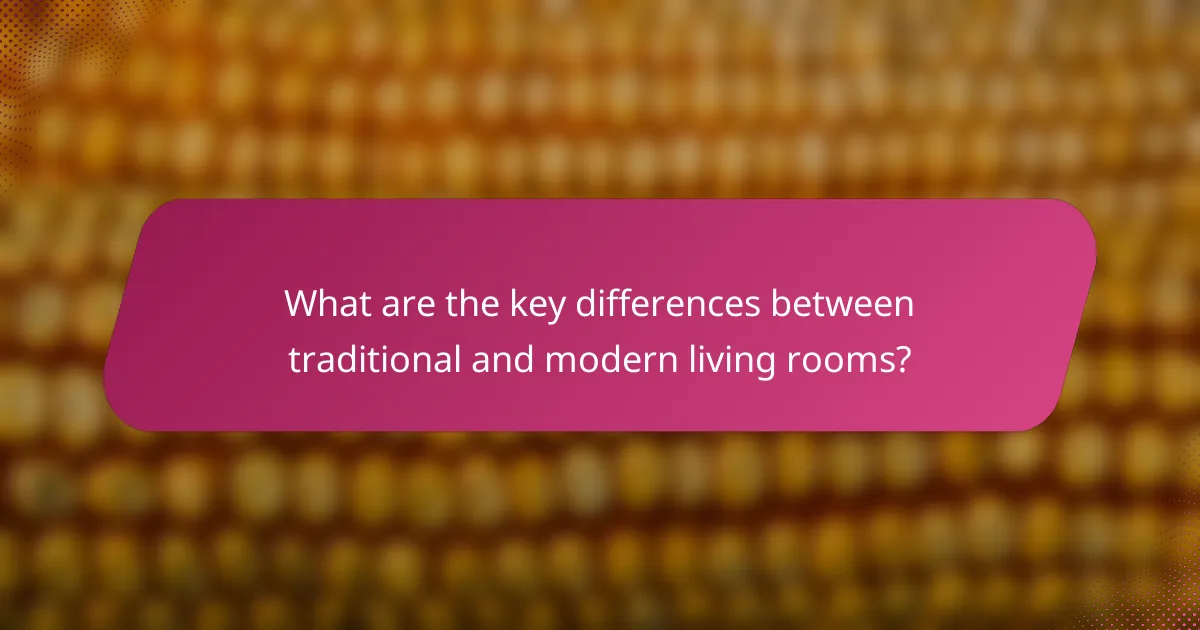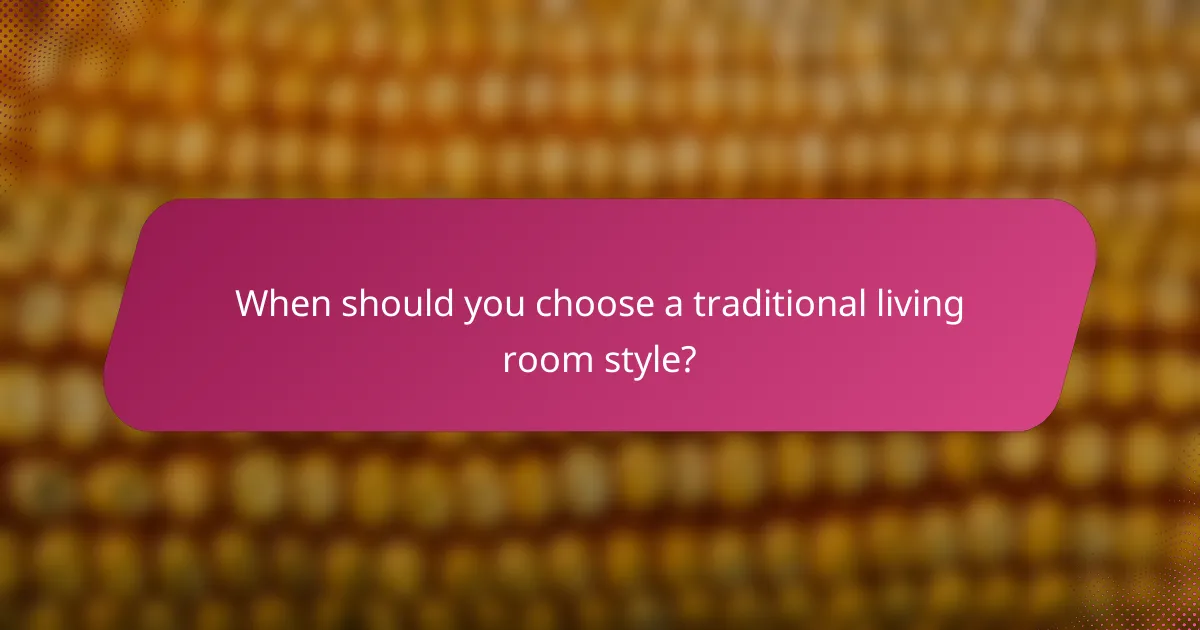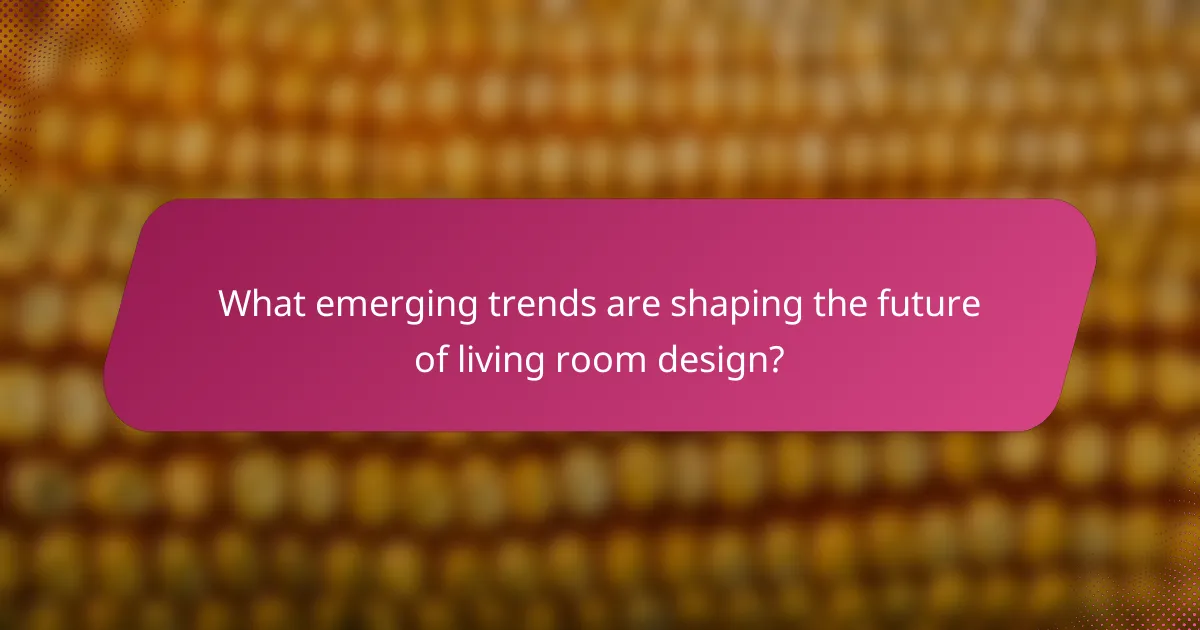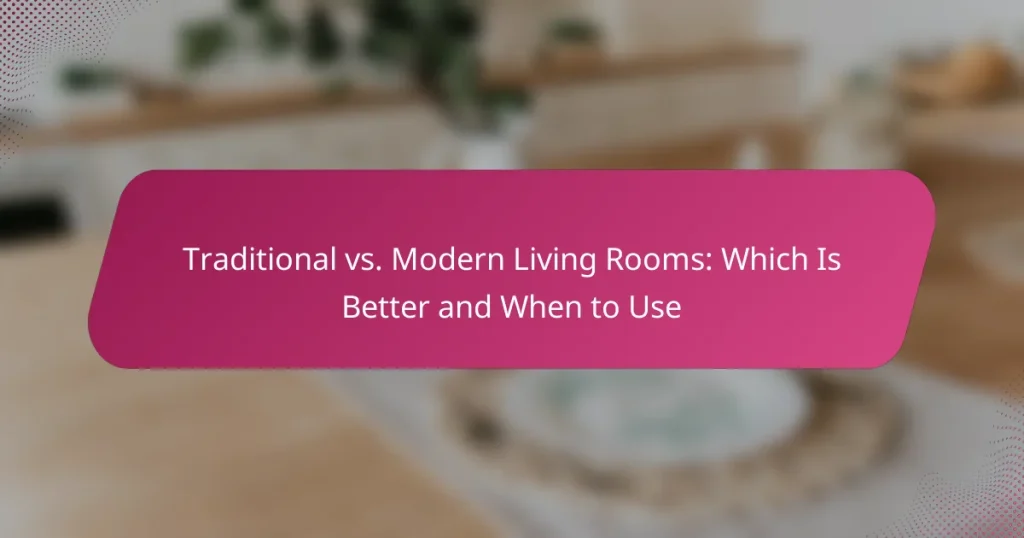When it comes to designing a living room, the choice between traditional and modern styles can significantly impact the atmosphere of your space. Traditional living rooms offer classic elegance with ornate details, while modern designs emphasize minimalism and functionality. Understanding the unique characteristics of each style can help you select the best option for your home and lifestyle needs.

What are the key differences between traditional and modern living rooms?
Traditional living rooms emphasize classic design and ornate details, while modern living rooms focus on minimalism and functionality. Understanding these differences can help you choose the right style for your space and lifestyle.
Design elements of traditional living rooms
Traditional living rooms often feature symmetrical layouts, elaborate moldings, and classic furniture styles such as wingback chairs and tufted sofas. Decorative elements like chandeliers, area rugs, and rich fabrics contribute to a warm and inviting atmosphere.
Common design motifs include floral patterns, dark wood finishes, and antique accessories. These elements create a sense of history and elegance, making traditional spaces feel timeless.
Design elements of modern living rooms
Modern living rooms prioritize clean lines, open spaces, and functional furniture. The design often incorporates geometric shapes and a lack of clutter, promoting a sense of simplicity and ease.
Furniture in modern living rooms tends to be sleek and low-profile, with materials like metal, glass, and light woods. This style emphasizes a connection to nature and often includes large windows or open layouts to enhance natural light.
Common materials used in traditional vs. modern styles
In traditional living rooms, materials like heavy woods, velvet, and silk are prevalent, contributing to a luxurious feel. Upholstered furniture often features intricate patterns and textures that add depth to the design.
Conversely, modern living rooms utilize materials such as leather, stainless steel, and concrete. These materials not only support the minimalist aesthetic but also enhance durability and ease of maintenance.
Color palettes in traditional and modern living rooms
Traditional living rooms typically showcase rich, warm colors like deep reds, golds, and browns. These hues create a cozy environment and often complement the ornate details found in traditional design.
Modern living rooms, on the other hand, favor neutral tones such as whites, grays, and blacks, often accented with bold splashes of color. This approach allows for flexibility in decorating and creates a fresh, airy feel in the space.

When should you choose a traditional living room style?
Choosing a traditional living room style is ideal when you want to create a warm, inviting atmosphere that reflects classic elegance. This style is characterized by rich colors, ornate furnishings, and a sense of timelessness, making it suitable for both formal and casual gatherings.
Best scenarios for traditional living rooms
Traditional living rooms work best in homes with historical architecture or in settings where a classic aesthetic is desired. They are particularly effective in larger spaces where furniture can be arranged to promote conversation and comfort.
Consider this style for family gatherings, holiday celebrations, or formal entertaining, as it fosters a cozy yet sophisticated environment. If your home is in a suburban area or a neighborhood with a classic design, a traditional living room can enhance the overall appeal.
Target audience for traditional living rooms
The target audience for traditional living rooms typically includes families, older adults, and individuals who appreciate classic design elements. This style appeals to those who value craftsmanship, quality materials, and a sense of history in their home decor.
Homeowners looking to create a welcoming space for guests or those who frequently host formal events will find traditional living rooms particularly appealing. Additionally, individuals with a preference for timeless aesthetics over modern trends are likely to favor this style.

When is a modern living room style more appropriate?
A modern living room style is more appropriate in settings that prioritize minimalism, functionality, and contemporary aesthetics. This style works well in urban environments or homes where space is limited, allowing for a clean and uncluttered look that maximizes usability.
Best scenarios for modern living rooms
Modern living rooms are ideal for open-concept homes where the living area flows into other spaces like dining or kitchen areas. This design approach enhances the sense of space and light, making it suitable for gatherings and social interactions.
Additionally, modern living rooms fit well in homes with a focus on technology, such as integrated smart home systems. The sleek lines and minimalist furniture can complement high-tech features, creating a cohesive and stylish environment.
Target audience for modern living rooms
The target audience for modern living rooms typically includes young professionals, urban dwellers, and families who appreciate a contemporary lifestyle. These individuals often value efficiency and aesthetics, seeking designs that reflect their dynamic lives.
Moreover, those who frequently entertain guests or work from home may prefer modern living rooms for their versatility and ease of maintenance. The clean surfaces and functional layouts cater to both relaxation and productivity, making them appealing to a wide range of users.

How do local trends influence living room styles in Los Angeles?
Local trends significantly shape living room styles in Los Angeles, reflecting the city’s unique blend of cultures and lifestyles. Factors such as climate, architecture, and popular aesthetics play a crucial role in determining design choices.
Popular living room styles in Los Angeles
In Los Angeles, popular living room styles include modern minimalist, mid-century modern, and bohemian chic. Modern minimalist designs focus on clean lines and open spaces, while mid-century modern emphasizes retro furniture and organic shapes. Bohemian chic incorporates vibrant colors and eclectic decor, appealing to the city’s artistic community.
Homeowners often blend these styles to create personalized spaces that reflect their tastes. For instance, a minimalist layout can be accented with bohemian textiles, creating a unique and inviting atmosphere.
Influence of local culture on design choices
Local culture in Los Angeles heavily influences design choices, with a strong emphasis on indoor-outdoor living due to the favorable climate. Many homes feature large windows and sliding doors that connect living spaces to outdoor areas, promoting a seamless flow between the two.
Additionally, the diverse cultural landscape encourages a mix of global influences in decor, from Mediterranean tiles to Asian-inspired furniture. This cultural richness allows residents to curate living rooms that are both stylish and reflective of their personal heritage.

What are the costs associated with traditional vs. modern living rooms?
The costs of traditional and modern living rooms can vary significantly based on style, materials, and furnishings. Traditional living rooms often involve higher expenses due to intricate designs and quality materials, while modern living rooms may offer more budget-friendly options with simpler aesthetics.
Average costs for traditional living room furnishings
Traditional living room furnishings typically range from moderate to high prices, often starting around $1,500 and going up to $10,000 or more. High-quality wood furniture, ornate decorations, and classic upholstery can drive costs higher.
When budgeting for a traditional living room, consider investing in key pieces like a solid wood coffee table, a well-crafted sofa, and elegant drapery. These elements can significantly enhance the overall ambiance but may require a larger upfront investment.
Average costs for modern living room furnishings
Modern living room furnishings generally offer a broader price range, starting from about $800 to $5,000. This style often emphasizes minimalism and functionality, which can lead to lower costs for basic items.
To create a modern living room, focus on sleek furniture, such as a simple sectional sofa or a glass coffee table. Many retailers offer affordable options that maintain a contemporary look without breaking the bank, making it easier to stay within budget.

What are the maintenance requirements for each style?
Traditional and modern living rooms have distinct maintenance needs that reflect their design elements. Traditional styles often require more upkeep due to intricate details, while modern designs typically prioritize simplicity and ease of care.
Maintenance needs for traditional living rooms
Traditional living rooms often feature ornate furniture, detailed woodwork, and rich fabrics, which can require regular maintenance. Dusting and polishing wood surfaces should be done frequently to maintain their luster, while upholstery may need professional cleaning every few years to prevent wear and staining.
Additionally, consider the upkeep of decorative elements like drapes and rugs, which may need to be cleaned or replaced periodically. Regular inspections for wear and tear on furniture can help prolong the life of these pieces.
Maintenance needs for modern living rooms
Modern living rooms are generally easier to maintain due to their minimalist design and use of durable materials. Furniture made from synthetic fabrics or leather can often be wiped clean, reducing the need for extensive cleaning. Regular vacuuming and occasional spot cleaning are usually sufficient to keep these spaces looking fresh.
While modern designs may require less frequent upkeep, it’s still important to check for any signs of damage, especially with technology components like televisions or sound systems. Keeping surfaces clutter-free can also simplify cleaning and maintenance tasks.

What emerging trends are shaping the future of living room design?
Emerging trends in living room design focus on sustainability, technology integration, and multifunctional spaces. These trends reflect a shift towards creating environments that are not only aesthetically pleasing but also practical and eco-friendly.
Sustainability in Living Room Design
Sustainability is becoming a cornerstone of modern living room design. Homeowners are increasingly opting for eco-friendly materials, such as reclaimed wood and recycled textiles, to minimize their environmental impact. This trend encourages the use of energy-efficient lighting and appliances, which can significantly reduce utility costs over time.
When designing a sustainable living room, consider incorporating plants to improve air quality and enhance aesthetics. Additionally, choosing furniture from sustainable sources can further align your space with eco-conscious values.
Technology Integration
Technology integration in living rooms is on the rise, with smart home devices becoming commonplace. Features like smart lighting, automated window treatments, and integrated sound systems allow for greater control and customization of the living space. This trend not only enhances convenience but also improves energy efficiency.
To effectively integrate technology, consider using a central hub that connects all devices, allowing for seamless operation. Ensure that your living room design accommodates power outlets and charging stations to keep devices easily accessible.
Multifunctional Spaces
Multifunctional spaces are increasingly popular as homeowners seek to maximize their living areas. This trend involves designing living rooms that serve multiple purposes, such as combining entertainment, work, and relaxation areas. Furniture that can easily transition between uses, like sofa beds or extendable tables, is essential in these designs.
When creating a multifunctional living room, prioritize flexible layouts that can adapt to different activities. Consider using room dividers or rugs to visually separate areas, making the space feel organized and purposeful.


